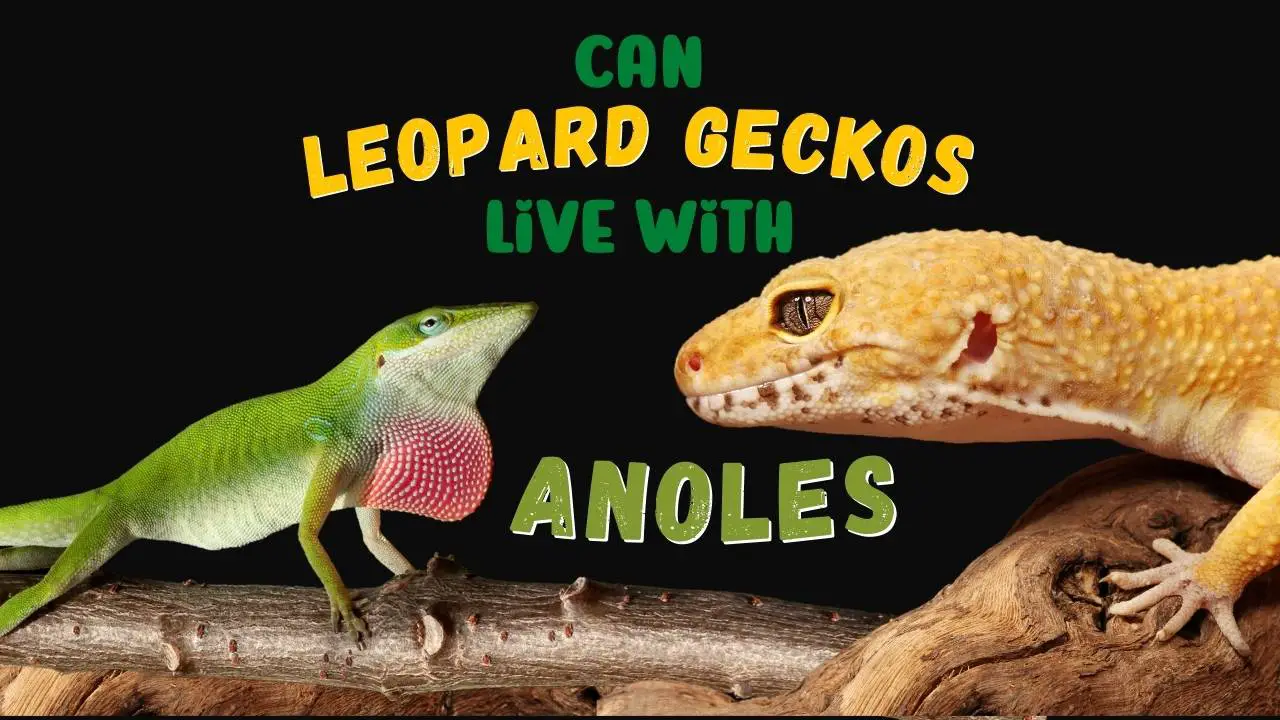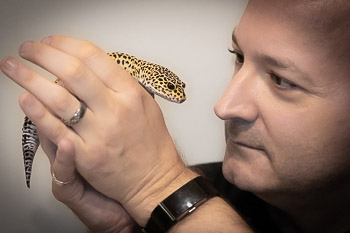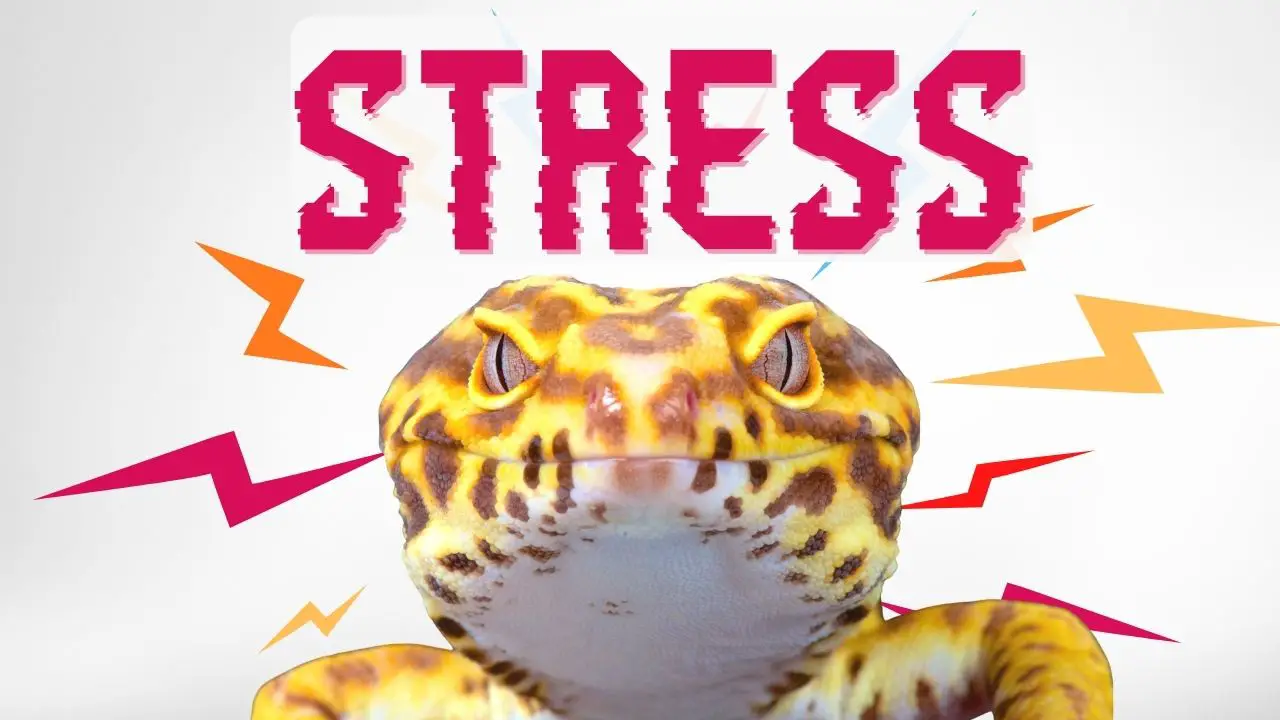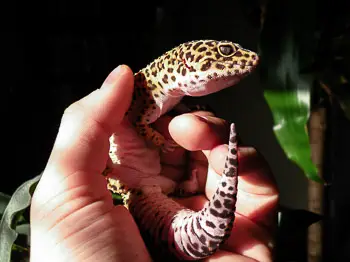Keeping reptiles can be addictive, and there are so many cool pets to bring home! While it may seem fun to have many different species cohabiting, it’s crucial to consider their unique habitats and requirements.
Leopard geckos and anoles should not be kept in the same tank. Leopard geckos are active during twilight and night time and require a dry, warm environment, while anoles are diurnal and need a humid environment with plenty of foliage and climbing opportunities.
These different needs – and other important considerations we’ll detail below – can lead to conflicts and stress for both species if housed together. It’s essential to provide each animal with the proper environment to thrive and prevent any potential harm that may come from mixing different species.
Read on to learn the potential risks and compatibility issues of housing leopard geckos with anoles, so you can make an informed decision for the health and happiness of your pets.
Key Takeaways
- Leopard geckos and anoles have different specific needs and behaviors that must be taken into consideration before mixing them.
- Housing leopard geckos and anoles together can lead to conflicts and stress due to their different environmental requirements, behaviors, and sleep schedules.
- Parasites, diseases, and territorial behavior can pose a risk to the health of both species when housed together.
- Leopard geckos are solitary animals and may not thrive in a social environment with anoles, while anoles are social animals that can thrive in groups.
- Both species can be territorial, and the larger leopard gecko may view an anole as prey
Different Habitat Requirements
Leopard geckos and anoles are popular pet reptiles (this includes both green anoles or brown anoles), and are fairly easy to take care of. The environmental conditions these two types of lizards need are completely different, and should be kept in separate tanks.
We know that leopard geckos come from desert regions and require a dry habitat with low humidity levels, while anoles need a moist environment with higher humidity levels.
Leopard geckos are terrestrial, and while they may climb and explore a bit, they’re not avid climbers like anoles. Leopard geckos benefit from tanks with more floorspace, while anoles like to climb and prefer taller tanks with more branches and climbing opportunities.
Leopard Gecko Natural Habitat
In their natural habitat, leopard geckos are found in Southwest Asia’s dry grassland landscapes, which are rocky desert environments. During the day, they typically burrow underground or find a hiding spot to stay out of the harsh sun and heat. This helps them maintain a temperature gradient ranging from the mid 70’s to low 90’s°F.
At dusk and into the night, they become more active, hunting for food. They are crepuscular (slightly different from nocturnal creatures), providing several hides within their tank is essential so that they can rest during the daytime. They have claws and stay close to the ground, and cannot climb glass or walls like some species of geckos.
Leopard geckos require an arid environment, with a 30-40% humidity level. It is essential to maintain an adequate temperature range in their tank as their body temperature can affect their digestion, metabolism, and immune system.
A well-equipped tank with hiding spots, tank accessories, and a water dish can replicate their natural habitat and make them feel at home. It’s crucial to ensure that the tank size is adequate and provides enough space for them to move around. (20 gallons is a good size for a single adult gecko.)
Anole Natural Habitat
Green anoles, also known as American chameleons, are found in southeastern United States, particularly in the subtropical forests and woodlands of Florida. They are arboreal creatures, meaning they are primarily found off the ground in trees and shrubs.
The natural habitat of green anoles affects their housing requirements significantly. It is important to provide an elevated tank with suitable hiding spots, such as driftwood, branches, and greenery. This is because green anoles are primarily tree-climbing creatures and feel most comfortable at elevated positions.
Additionally, green anoles require a specific temperature range in their tank. They thrive in temperatures ranging from 75-85°F, with a humidity level around 60-80%.
Ideally, green anoles should be housed in a solitary tank or one with up to four females per male. This is because anoles are territorial creatures and may become aggressive if multiple males are kept in the same tank. By providing adequate living space and adhering to humidity and temperature requirements, green anoles can live a long and healthy life in captivity.
Humidity & Temperature
Leopard geckos come from dry desert environments with arid air. You should keep the humidity level in their enclosure between 30-40%, which is fairly dry. Leopard geckos need a temperature gradient ranging from about 80 °F (27 °C) and 90 °F (32 °C). There should be a warm and cool side of the tank, and the lower temperatures can dip into the mid 70’s during the night time.
Anoles come from a more humid tropical environment with high humidity. You’ll probably want to mist their enclosure, which would be detrimental to leopard geckos. Anoles do best between 75-85°F which, while warm, isn’t as hot as leopard geckos prefer.
Your choices for your pet’s environment are going to affect the humidity. The size of your enclosure can also play a role in maintaining proper humidity levels. A smaller enclosure may dry out quicker, while a larger enclosure may require a humidifier or frequent misting if you’re housing tropical lizards.
The temperature range also affects humidity levels. Higher temperatures will evaporate more water and decrease the humidity. Lower temperatures may increase the humidity. It’s important to keep the temperature within the ideal range for your species of lizard (and understand how temperature can affect humidity levels.)
You should provide your leopard gecko or anoles with a suitable environment for their species. Their temperature and humidity requirements are different, and reflect the parts of the world they come from.
Conflicting Sleep Schedules
Anoles are diurnal, meaning they are awake and active during the day. Leopard geckos, on the other hand, are usually in their hides sleeping during daylight hours to emerge at twilight to hunt. They are most active between dusk and dawn.
The conflicting sleep schedules between anoles and leopard geckos create another challenge for cohabitation. This can lead to stress and aggression between the two species, as they may disturb each other’s sleep patterns. Neither will feel truly safe sleeping when other tank mates are moving about.
Parasites and Diseases
Parasites and diseases can pose a risk to the health of both species when housed together, as each species can infect the other.
Parasites and diseases can be transmitted through direct contact with feces, bodily fluids, and even through shared food and water sources. Additionally, common parasites that can affect both leopard geckos and anoles include mites, ticks, and worms, while common diseases include respiratory infections and skin diseases.
Preventative measures for avoiding parasitic infections and diseases include keeping the enclosure clean and regularly disinfecting it, separating any sick or infected reptiles immediately, and practicing good hygiene when handling and feeding
Both Species Can be Territorial
Watch out, because both leopard geckos and anoles can get territorial when they’re in close proximity, especially the males of both species. This means they may become aggressive towards each other, resulting in injury or death.
In this particular fight, leopard geckos have an advantage:
Size Difference: Leopard Gecko vs Anole
Leopard geckos are typically larger and stockier than anoles, which can give them an advantage should there be a conflict. A fight over territory can lead to bites, injuries, or dropped tails. Due to the leopard gecko’s larger size, they may view an anole as prey.
By considering factors such as these, you can make an informed decision about whether or not housing leopard geckos and anoles together is the right choice for your pets. Remember to always put the needs and well-being of your animals first, and to seek advice from a qualified veterinarian or reptile expert if you have any questions or concerns. With proper care and attention, both leopard geckos and anoles can thrive in their own unique environments.
Lizard Species Compatibility Issues
Leopard geckos and anoles may look like they could live together peacefully in the same terrarium, but unfortunately, they cannot.
| Leopard Gecko | Anoles | |
| Size | 7-10 inches | 4-8 inches |
| Behavior| | Crepuscular/Nocturnal | Diurnal |
| Territorial | Yes | Yes |
| Space Requirements (one adult) | 20 gallon tank | 10 gallon tank |
Anoles require a vertical space to climb and jump, while leopard geckos prefer a horizontal space to crawl and hide. This difference in preference can lead to territorial disputes and stress between the two species.
Anoles need a higher humidity level, while leopard geckos require a dry environment. This can result in health issues for one or both species if the humidity level is not properly regulated.
Anoles are active during daylight, while leopard geckos are active at night. This difference in their activity cycle may cause stress and lack of proper rest for either species.
Anoles are social animals that can thrive in groups, while leopard geckos are solitary animals that prefer to live alone. Differences in social behavior may lead to stress and aggression between the two species.
This means that keeping them together in the same terrarium will result in one or both species experiencing stress and possibly becoming sick. Therefore, it is not recommended to keep leopard geckos and anoles together in the same enclosure.
Wrap Up – Leopard Geckos vs Anoles
Leopard Geckos and anoles are both fascinating species that are loved by pet reptile enthusiasts. As animal lovers ourselves, we understand the desire to have multiple pets in one habitat. However, it’s important to consider the specific needs and behaviors of each species before mixing them.
It’s not recommended to house leopard geckos with anoles. These two species have different habitat requirements, sleep schedules, and can be territorial. Moreover, different lizard species can transmit parasites and diseases to each other, causing stress and health problems.
While it may seem like a fun idea to mix different reptile species, it’s always best to research their needs and compatibility before attempting to house them together. It’s important for pet owners to prioritize the health and well-being of their pets, and sometimes that means keeping them separate.
Find out if leopard geckos can share a tank with a crested gecko or bearded dragon.





